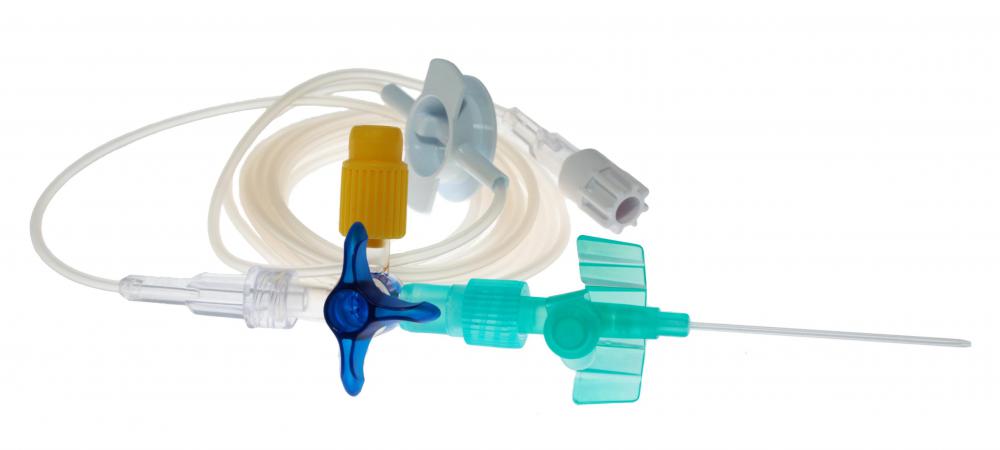At WiseGEEK, we're committed to delivering accurate, trustworthy information. Our expert-authored content is rigorously fact-checked and sourced from credible authorities. Discover how we uphold the highest standards in providing you with reliable knowledge.
What is Parenteral Nutrition?
When food and drink cannot be eaten, digested or excreted via the gastrointestinal tract, it might become necessary to use parenteral nutrition to ensure that a patient receives the energy and nutrients he or she needs to prevent starvation or malnutrition. Parenteral nutrition is administered via a catheter and bypasses the gastrointestinal tract entirely by supplying nutrients in a form that does not require digestion. Nutrition can be provided for infants and children as well as adults, but babies and children require very close monitoring to ensure that they receive an optimal level of nutrition.
There are two categories of parenteral nutrition: partial and total. Partial parenteral feeding generally is for people who can eat small amounts of food but are not able to eat enough food to provide all of the nutrition and energy they need. People who need partial parenteral feeding are fitted with a peripheral intravenous catheter, which is a catheter that is inserted into a peripheral location on their body, such as a hand or arm. Most people who need this type of intravenous feeding are given a solution containing glucose and emulsified fats to supplement the food they eat.

When a person is unable to eat any food, he or she might need total parenteral nutrition. This type of intravenous feeding provides protein, sugars, vitamins, minerals and electrolytes to ensure that the person can maintain proper electrolyte and fluid balance as well as nutrient and energy requirements. High-protein nutrition is given to ensure that the person’s body does not begin breaking down muscle for energy. This method is used to provide nutrition for people with gastrointestinal diseases, such as Crohn’s disease, or other problems that prevent them from eating and drinking, such as such as bowel obstruction.

Parenteral feeding frequently is administered in a hospital. Often, someone who needs intravenous feeding can administer their own nutrition at home after a catheter has been properly inserted. The home use of parenteral feeding methods typically is provided for people who need to use this feeding method for a long period of time.
People who use parenteral nutrition have a risk of bacterial infection or fungal infection at the site of the catheter insertion. There is a low risk of liver failure if a person is given parenteral feeding solutions with excess glucose or an incorrect ratio of different fatty acids. When someone is given total parenteral feeding, long-term disuse of the gastrointestinal tract can lead to inflammation of the gallbladder.
AS FEATURED ON:
AS FEATURED ON:













Discussion Comments
@wavy58 – Partial parenteral nutrition can be really helpful when you can't stop having diarrhea and can't eat anything. My boyfriend has Crohn's disease, and it once got so bad that he had to rely on a feeding tube for awhile.
With Crohn's, you can have horrible intestinal cramps and diarrhea at a moment's notice. It can really make life miserable, and it's hard to make plans to go out anywhere.
He got so sick from it that he just had to stop eating. That's when he finally agreed to go in the hospital for awhile to recover. Without the parenteral nutrition, he might have suffered malnutrition or even died.
I had to have peripheral parenteral nutrition when I had rotavirus as a child. The virus made me vomit and have diarrhea endlessly, so I could not keep anything in my system.
They treated my nausea and diarrhea with intravenous drugs, and they pumped me full of nutrients until I was able to eat on my own again. I would have dehydrated and died without medical intervention, so even though I screamed and cried when they put the catheter in my arm, I'm glad they gave it to me.
My neighbor had his throat and esophagus damaged in the hospital. They were inserting a breathing tube for his surgery, and when they were pulling it out, they damaged his tissue, so he could not eat.
He had to have total parenteral nutrition for a long time. He had a tube in his abdomen, and his wife would help him with the feeding.
He said that he missed the taste of food so badly, so his wife would not eat in the room with him. When he finally got to eat some bland mashed potatoes, he said that those were the best potatoes he had ever eaten!
I would be scared to receive either total or partial parenteral nutrition. It sounds like the risk of infection or inflammation is pretty high, and I would be afraid of doing it wrong.
My grandmother had to have total parenteral nutrition for awhile, and I was so glad that she had a live-in nurse to help her with this. This nurse knew all the correct proportions and dosages to give her, so we didn't have to worry about figuring it all out ourselves.
Post your comments